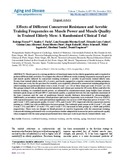Mostrar el registro sencillo del ítem
Effects of different concurrent resistance and aerobic training frequencies on muscle power and muscle quality in trained elderly men: a randomized clinical trial
| dc.creator | Ferrari, Rodrigo | es_ES |
| dc.creator | Fuchs, Sandra C. | es_ES |
| dc.creator | Kruel, Luiz Fernando Martins | es_ES |
| dc.creator | Lusa Cadore, Eduardo | es_ES |
| dc.creator | Alberton, Cristine Lima | es_ES |
| dc.creator | Pinto, Ronei Silveira | es_ES |
| dc.creator | Radaelli, Régis | es_ES |
| dc.creator | Schoenell, Maira | es_ES |
| dc.creator | Izquierdo Redín, Mikel | es_ES |
| dc.creator | Tanaka, Hirofumi | es_ES |
| dc.creator | Umpierre, Daniel | es_ES |
| dc.date.accessioned | 2018-08-31T08:07:52Z | |
| dc.date.available | 2018-08-31T08:07:52Z | |
| dc.date.issued | 2016 | |
| dc.identifier.issn | 2152-5250 | |
| dc.identifier.uri | https://hdl.handle.net/2454/30332 | |
| dc.description.abstract | Muscle power is a strong predictor of functional status in the elderly population and is required to perform different daily activities. To compare the effects of different weekly training frequencies on muscle power and muscle quality induced by concurrent training (resistance + aerobic) in previously trained elderly men. Twenty-four trained elderly men (65 ± 4 years), previously engaged in a regular concurrent training program, three times per week, for the previous five months, were randomly allocated to concurrent training programs in which training was performed either twice a week (2·week-1, n = 12) or three times per week (3·week-1, n = 12). The groups trained with an identical exercise intensity and volume per session for 10 weeks. Before and after the exercise training, we examined muscle power, as estimated by countermovement jump height; knee extensor isokinetic peak torque at 60 and 180o.s-1; and muscle quality, a quotient between the one-repetition maximum of the knee extensors and the sum of quadriceps femoris muscle thickness determined by ultrasonography. Additionally, as secondary outcomes, blood pressure and reactive hyperemia were evaluated. Two-way ANOVA with repeated measures were used and statistical significance was set at α = 0.05. Muscular power (2·week-1: 7%, and 3·week-1: 10%) and muscle quality (2·week-1: 15%, and 3·week-1: 8%) improved with the concurrent exercise training (p < 0.001) but with no differences between groups. The isokinetic peak torque at 60 (2·week-1: 4%, and 3·week-1: 2%) and 180o.s-1 (2·week-1: 7%, and 3·week-1: 1%) increased in both groups (p = 0.036 and p=0.014, respectively). There were no changes in blood pressure or reactive hyperemia with the concurrent training. Concurrent training performed twice a week promotes similar adaptations in muscular power and muscle quality when compared with the same program performed three times per week in previously trained elderly men. | en |
| dc.format.extent | 8 p. | |
| dc.format.mimetype | application/pdf | en |
| dc.language.iso | eng | en |
| dc.publisher | Aging and Disease | en |
| dc.relation.ispartof | Aging and Disease, volume 7, number 6; 697-704, December 2016 | en |
| dc.rights | © 2016 Ferrari, R. et al. This is an open-access article distributed under the terms of the Creative Commons Attribution License, which permits unrestricted use, distribution, and reproduction in any medium, provided the original author and source are credited. | en |
| dc.rights.uri | https://creativecommons.org/licenses/by/4.0/ | |
| dc.subject | Exercise | en |
| dc.subject | Combined training | en |
| dc.subject | Resistance training | en |
| dc.subject | Aerobic training | en |
| dc.subject | Aging | en |
| dc.subject | Functional outcomes | en |
| dc.title | Effects of different concurrent resistance and aerobic training frequencies on muscle power and muscle quality in trained elderly men: a randomized clinical trial | en |
| dc.type | info:eu-repo/semantics/article | en |
| dc.type | Artículo / Artikulua | es |
| dc.contributor.department | Ciencias de la Salud | es_ES |
| dc.contributor.department | Osasun Zientziak | eu |
| dc.rights.accessRights | info:eu-repo/semantics/openAccess | en |
| dc.rights.accessRights | Acceso abierto / Sarbide irekia | es |
| dc.identifier.doi | 10.14336/ad.2016.0504 | |
| dc.relation.publisherversion | https://doi.org/10.14336/ad.2016.0504 | |
| dc.type.version | info:eu-repo/semantics/publishedVersion | en |
| dc.type.version | Versión publicada / Argitaratu den bertsioa | es |






